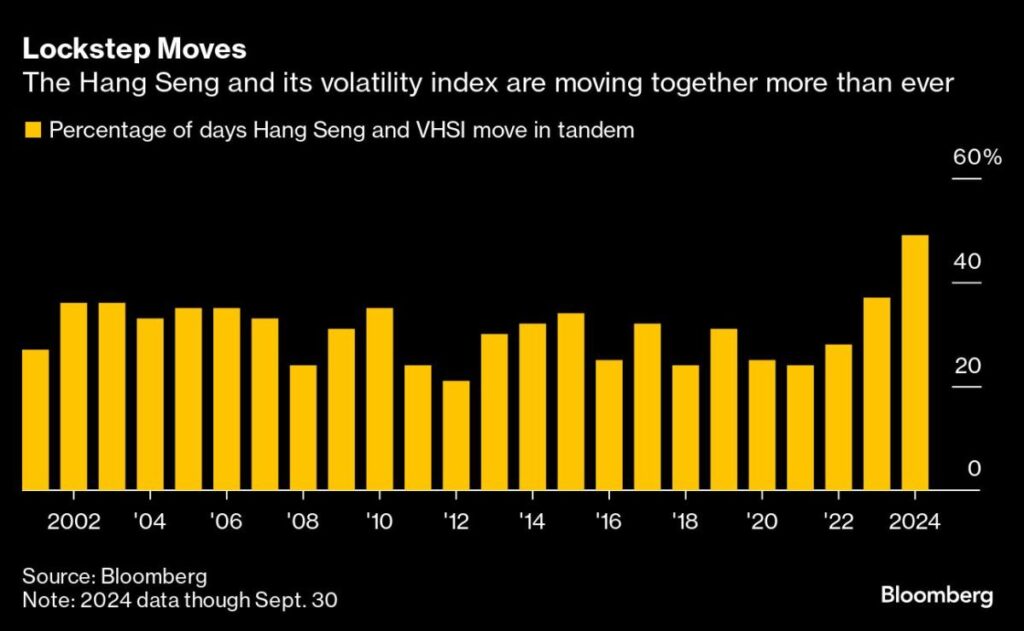(Bloomberg) — For six straight days, Hong Kong’s benchmark stocks gauge and a measure tracking the cost of its options moved in the same direction. The last time that happened, the Hang Seng Index went on to surge 30% in about two months.
Most Read from Bloomberg
Only time will tell whether Chinese and Hong Kong markets will climb further, but for now the bull spirits have definitely come out. The Hang Seng surged 16% in the five days through Monday, its biggest rally in more than two years, and China’s CSI 300 Index staged its best daily jump since 2008 to close in a bull market.
The Hong Kong stocks gauge and volatility index both climbed again on Wednesday after a holiday on Tuesday. China’s market stayed closed for the holiday.
Also read: FOMO Grips China Stock Buyers on ‘Epic’ Trading Day Before Break
With China’s stimulus spree, the stars may be finally aligning for market bulls. The nation announced a slew of measures to boost its economy — from interest rate cuts to lower bank reserve requirements, billions of dollars to support equities and relaxed rules for homebuyers. The stocks frenzy percolated through the options market, where investors chasing the rally pushed up the price of near-term contracts.
“The Chinese authorities are doing everything that they said they wouldn’t do,” said Gary Dugan, chief executive officer at Global CIO Office in Singapore. “The helicopter money and the support to the real estate sector reverse their previous plans of fiscal discipline and real estate sector reset. It’s probably best for the moment not to vote against further gains in the Chinese equity market.”
After the Hang Seng and HSI Volatility Index both fell on Sept. 23, the two gauges climbed in unison for the five days through Monday, both ending at highs. They hadn’t moved together for so long since November 2022, shortly after the Hang Seng hit a 13-year low. The stocks gauge then rallied through an almost 11-month high in January 2023.
Volatility indexes — like the Cboe Volatility Index, or VIX, in the US — are often viewed as fear gauges because they tend to rise with growing hedging demand when stocks slump. If both the equity and swings indexes move together, it can be a warning sign.
But it’s a different story in Asian markets, according to Jason Lui, head of Asia-Pacific equity and derivatives strategy at BNP Paribas.
“Investors tend to chase upside exposure via call options buying, resulting in the ‘spot up, vol up’ phenomenon,” Lui said. “The jump in volatility tends to be amplified if the overall market sentiment is low or depressed as it is the case in the HK/China market this time.”
The Hang Seng and its volatility measure are heading for a record correlation this year, moving in unison on 49% of the days. In the US, the S&P 500 Index and VIX have had similar gyrations 21% of the time historically.
UBS Group AG estimates the Hang Seng has more room for gains. The Swiss bank increased its year-end target to 22,100, 4.6% above the Monday close. Global funds that had reduced their China exposure are poised to come back to the market, according to Value Partners.
“There should be a significant amount of money that needs to be allocated to stocks in Hong Kong and mainland China,” said Chen Jun Yu, the firm’s deputy chief investment officer for equities. “We anticipate that the China equity market could experience a mid to long-term rally.”
(Adds Wednesday’s trading in third paragraph)
Most Read from Bloomberg Businessweek
©2024 Bloomberg L.P.
Read the full article here

